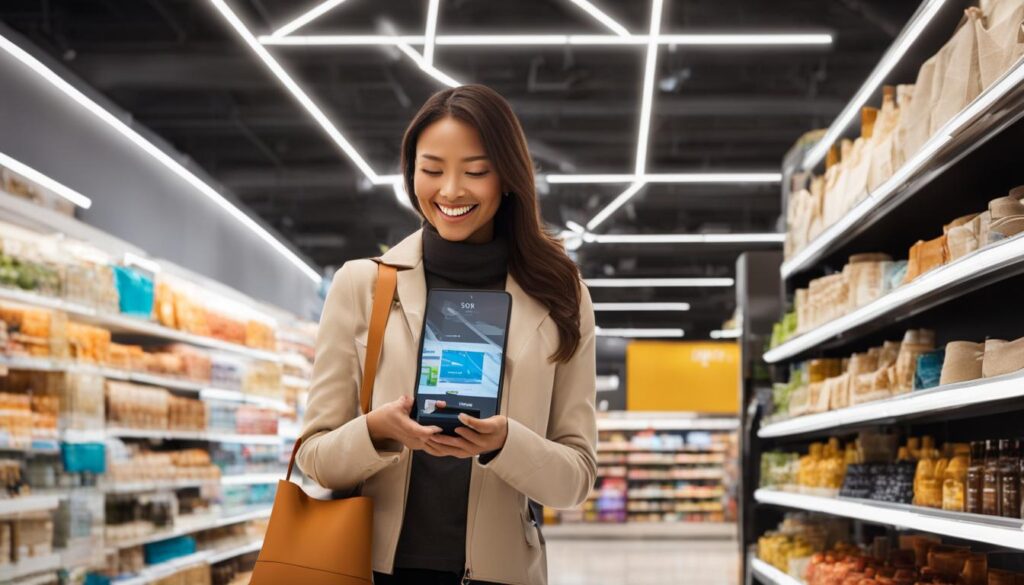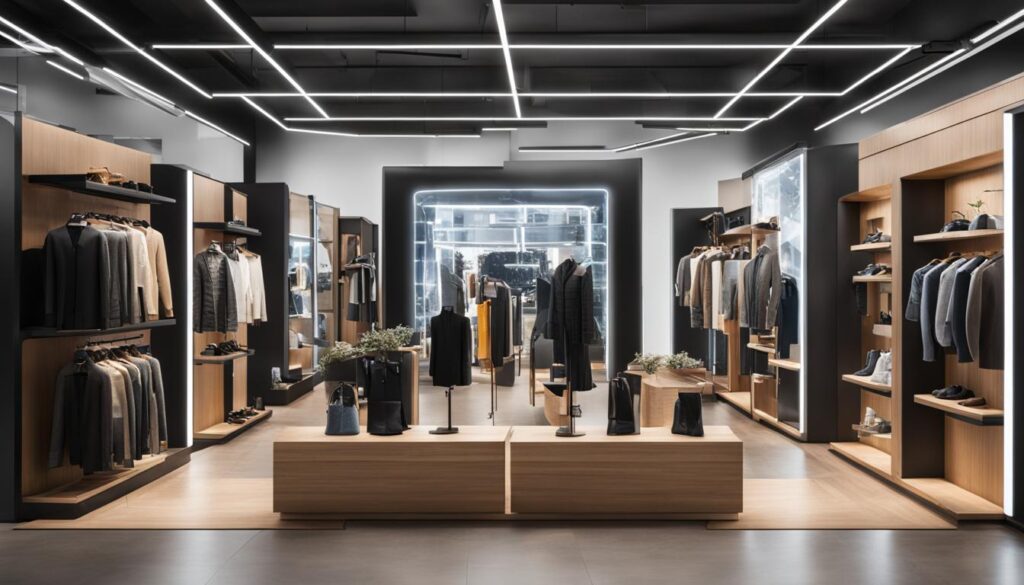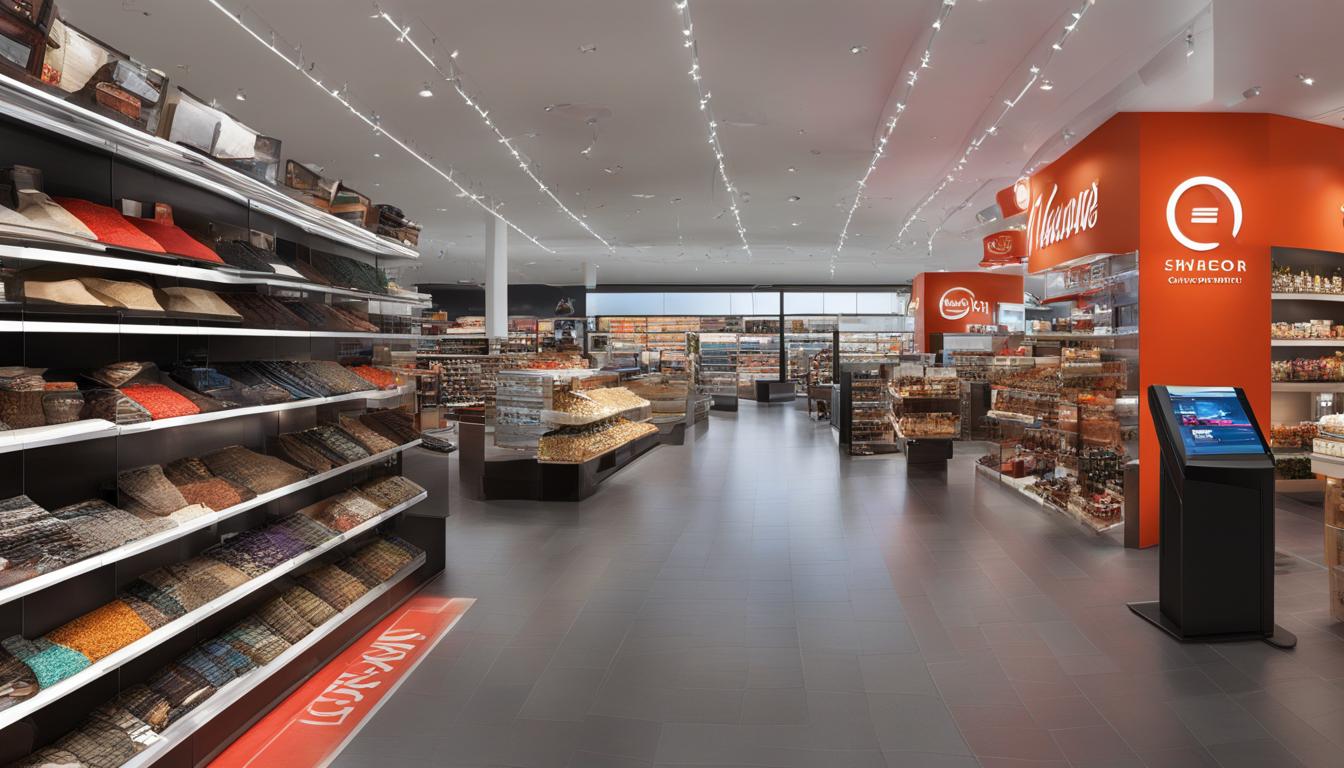Advanced technologies have revolutionized the retail industry, bringing about significant changes in how stores operate and consumers shop.
The continuous advancements in technology have paved the way for seamless integration between online and offline shopping experiences, simplifying store navigation, enhancing customer and employee experiences through augmented reality, and driving greater automation in retail processes.
Contents
- 1 Bridging the Gap Between Online and Offline Shopping Experiences
- 2 Simplifying Store Navigation With Indoor Positioning
- 3 Transforming Customer and Employee Experience With Augmented Reality
- 4 Conclusion
- 5 FAQ
- 5.1 How has technology advanced the retail industry, and what changes have stores undergone?
- 5.2 How do retailers bridge the gap between online and offline shopping experiences?
- 5.3 How do indoor positioning systems simplify store navigation?
- 5.4 How does augmented reality transform the customer and employee experience in stores?
- 5.5 What is the overall impact of technology on stores and the retail industry?
- 6 Source Links
Key Takeaways:
- Technology has played a crucial role in transforming the retail industry, improving customer experiences, and streamlining operations.
- The integration of online and offline channels has bridged the gap between digital and physical shopping, offering convenience and flexibility to consumers.
- Indoor positioning systems have simplified store navigation, enabling customers to find their desired items more easily and providing retailers with valuable data on customer behavior.
- Augmented reality has revolutionized how customers interact with products and aided retail workers in various tasks, such as shelf management.
- As technology advances, stores must embrace innovation to stay competitive and meet the evolving demands of consumers.
Bridging the Gap Between Online and Offline Shopping Experiences
The rise of online shopping has revolutionized the retail industry, integrating online and offline shopping experiences. To meet the changing demands of consumers, retailers have adopted various strategies to bridge the gap between the online and offline worlds.
One of the key ways retailers achieve this is by implementing services like buy online pick up in-store (BOPIS), same-day delivery, and online shipping.
These services allow customers to enjoy the convenience of online shopping while still having the option to visit physical stores for immediate access to their purchases. This seamless integration allows customers to have a flexible and personalized shopping experience.
Also read: Industrial Tech’s Role in U.S. Sectionalism Dynamics
To enable a seamless shopping experience, retailers need to implement point-of-sale (POS) systems that can handle online and in-store purchases. This requires a unified and connected system that integrates with other technologies, such as inventory and customer relationship management (CRM) software.
By integrating online and offline transactions, retailers can streamline operations, improve inventory management, and provide a better overall experience for customers.
Another important aspect of bridging the gap between online and offline shopping experiences is accepting various digital payment methods. Fintech innovation has played a crucial role in enabling retailers to accept alternative payment options beyond traditional cash and credit cards.
Retailers now accept buy, pay later options, QR code payments, virtual payments, and cryptocurrency. This allows customers to choose the payment method that suits them best, making transactions faster, more secure, and more convenient.
Overall, the integration of online and offline shopping experiences and the acceptance of various digital payment methods have transformed the retail industry.
By embracing innovation in fintech and implementing the necessary technologies, retailers can provide customers with a seamless shopping journey that combines the convenience of online shopping with the tangible and personalized experience of in-store shopping.
In today’s fast-paced retail environment, providing a seamless shopping experience for customers is a top priority for retailers. Implementing indoor positioning systems (IPS) has emerged as a game-changer, simplifying store navigation and enhancing the overall shopping experience.
Indoor positioning systems utilize various hardware options such as visual markers, Bluetooth beacons, Wi-Fi RTT, or Ultra-wideband (UWB) to enable precise indoor navigation. By leveraging these technologies, retailers can effectively guide shoppers to their desired items, minimizing search time and frustration.
Also read: Explore Trihex Technology: Cutting-Edge Innovation
One notable example of IPS implementation is Target’s Bluetooth IoT lighting systems. These systems interact with Target’s mobile app, providing customers access to store maps and helping them locate specific items within the store.
Customers can now easily navigate the aisles, following targeted suggestions based on IPS tracking.
“Indoor positioning systems have revolutionized the way customers interact with stores. With precise location tracking, retailers can offer personalized recommendations and streamline the shopping process.”
IPS tracking also provides retailers with valuable insights into customer traffic and item location within the store.
By analyzing this data, retailers can make informed decisions on product placement, optimize store layouts, and create personalized shopping experiences. Targeted suggestions based on IPS tracking help retailers enhance customer engagement and increase overall sales.
Implementing IPS in retail stores benefits customers and improves store operations. By accurately tracking customer traffic, retailers can identify popular areas of the store and allocate resources accordingly. Additionally, IPS tracking helps identify underperforming areas requiring attention, ensuring efficient store management.
With the power of IPS, retailers can simplify store navigation, provide targeted suggestions, track customer traffic, and optimize item location. These advancements create a customer-centric environment that enhances the overall shopping experience and boosts customer satisfaction.
| Benefits of Indoor Positioning Systems (IPS) | Examples |
|---|---|
| 1. Simplifies store navigation | – Target’s Bluetooth IoT lighting systems |
| 2. Enables targeted suggestions based on IPS tracking | – Retailers’ mobile apps with integrated IPS |
| 3. Tracks customer traffic and item location | – Data analytics platforms for IPS tracking |
| 4. Optimizes store operations | – Efficient allocation of resources based on customer traffic |
By embracing indoor positioning systems, retailers can create a seamless shopping experience, improve operational efficiency, and provide targeted customer suggestions.
IPS will remain a key technology to simplify store navigation and enhance customer satisfaction as the retail industry evolves.

Transforming Customer and Employee Experience With Augmented Reality
Augmented reality (AR) has revolutionized the retail industry, transforming customer and employee experience. With the advent of virtual try-on technology, customers can now visualize how products will look on them, enhancing their online shopping experience and increasing confidence in their purchasing decisions.
Retail giants like Sephora, Target, and Ikea have already implemented this technology, allowing customers to try on makeup, furniture, and home decor virtually.
But AR’s impact goes beyond the customer experience. It also aids retail workers in various tasks, improving overall store efficiency.
AR navigation, powered by indoor positioning systems, guides customers through the store, making finding the items they need easier. This saves customers time and reduces the workload for retail workers who are often asked for directions or product locations.
Moreover, AR technology can assist retail workers in visualizing shelf setups and identifying problem areas. By combining AR with AI-based object detection, retail workers can quickly identify out-of-place or damaged products, improving shelf management and ensuring a visually appealing store layout.
AR technology is transforming the retail industry by creating immersive and digitally consistent experiences for customers while aiding retail workers with other crucial tasks. It enhances the customer journey and improves operational efficiency, making it a game-changer for the industry.
A prime example of AR’s impact can be seen in the cosmetics industry, where virtual try-on technology allows customers to try different makeup products without physically touching them.
This prevents product contamination and gives customers the freedom to experiment with new looks and shades before making a purchase. It increases customer satisfaction and reduces the need for returns, ultimately boosting revenue for retailers.
AR’s potential also extends to virtual showrooms, where customers can experience products in a digital space, such as trying on clothes or visualizing furniture in their homes. This eliminates physical space limitations and allows retailers to showcase a broader range of products without the need for extensive inventory.
The possibilities for transforming customer and employee experiences in the retail industry are endless as AR technology advances. From personalized shopping experiences to improved store navigation and innovative visual merchandising, AR is undoubtedly reshaping the future of retail.
The Benefits of AR in Retail:
- Enhanced customer experience through virtual try-on technology
- Improved store navigation with AR-powered indoor positioning systems
- Aided retail workers in visualizing shelf setups and identifying problem areas
- Expanded product range through virtual showrooms and digital experiences
- Increased customer satisfaction and reduced returns
Implementing AR technology creates a competitive edge for retailers and ensures they stay ahead of the curve in an ever-evolving industry.

With the help of augmented reality, retailers are transforming the retail landscape, offering customers immersive experiences while streamlining operations and empowering retail workers with innovative tools.
Conclusion
Technology has profoundly impacted stores, transforming the retail industry as a whole. The integration of online and offline channels, the implementation of indoor positioning systems, the adoption of augmented reality, and the use of artificial intelligence have revolutionized how stores operate and interact with customers.
These technological advancements have improved customer experiences, streamlined operations, and increased productivity.
By embracing technology, stores have bridged the gap between online and offline shopping experiences, offering services such as buy online pick up in-store (BOPIS) and same-day delivery.
Digital payment methods have also evolved, providing customers with more convenient purchasing methods. Furthermore, indoor positioning systems have simplified store navigation, helping customers easily find their desired items while also providing valuable data for retailers to optimize their store layouts and product placements.
Augmented reality has transformed both customer and employee experiences. Customers can now virtually try on products and visualize their appearance before purchasing, enhancing the online shopping experience.
Meanwhile, retail workers can utilize augmented reality to aid in tasks such as shelf management and product identification, improving overall store efficiency.
As technology advances, stores must adapt and embrace innovations to stay competitive in the ever-changing retail landscape. The changing face of stores with technological growth reflects the continuous evolution of the retail industry, driven by these advancements.
With technology shaping the future of retail, stores can enhance customer experiences, optimize operations, and thrive in the digital age.
FAQ
How has technology advanced the retail industry, and what changes have stores undergone?
Advanced technologies have revolutionized the retail industry, significantly changing how stores operate and how customers experience shopping. Technology has reshaped the retail landscape, from integrating online and offline channels to implementing indoor positioning systems and adopting augmented reality.
How do retailers bridge the gap between online and offline shopping experiences?
Retailers bridge the gap between online and offline shopping experiences by offering services such as buy online pick up in-store (BOPIS), same-day delivery, and online shipping. They also need to implement point-of-sale (POS) systems that can handle online and in-store purchases, creating a seamless customer shopping experience. Retailers have also adapted to accepting various digital payment methods, including buy now, pay later, QR code payments, virtual payments, and cryptocurrency.
Indoor positioning systems (IPS) help simplify store navigation by guiding customers to their desired items. Retailers implement IPS solutions that utilize hardware options such as visual markers, Bluetooth beacons, Wi-Fi RTT, or Ultra-wideband (UWB) technology to enable precise indoor navigation. Retailers like Target have even implemented Bluetooth IoT lighting systems that interact with their mobile apps, providing customers with maps and guides to locate specific items in-store. IPS tracking also provides valuable data on customer behavior, which retailers can use to improve product placement, offer targeted suggestions, and enhance overall store operations.
How does augmented reality transform the customer and employee experience in stores?
Augmented reality (AR) transforms store customer and employee experience by providing immersive and digitally consistent experiences. Customers can use virtual try-on technology to visualize how products will look on them, enhancing the online shopping experience. AR navigation, powered by indoor positioning systems, guides customers through the store, making it easier to find items. AR can also aid retail workers with tasks such as visualizing shelf setups and identifying out-of-place or damaged products using AI-based object detection. These advancements improve shelf management, store efficiency, and overall customer satisfaction.
What is the overall impact of technology on stores and the retail industry?
Technology has profoundly impacted stores, revolutionizing the retail industry as a whole. It has improved customer experiences, streamlined operations, and increased productivity. The changing face of stores with technological growth reflects the continuous evolution of the retail industry, driven by advancements in technology.




